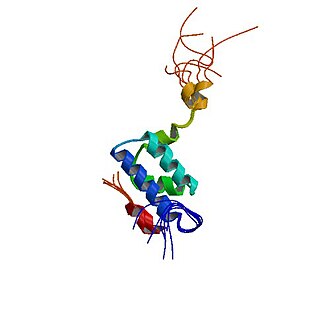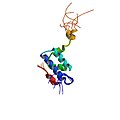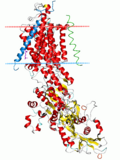Translocase
Enzyme that assists in moving another molecule, usually across a membrane
Translocase is a type of enzyme that facilitates the movement of molecules across biological membranes. These enzymes are crucial for various cellular processes, including the transport of proteins and other macromolecules into and out of organelles such as the mitochondria, chloroplasts, and the endoplasmic reticulum.
Function[edit]
Translocases play a vital role in the translocation of proteins across membranes. They are involved in the import and export of proteins, ensuring that proteins reach their correct cellular or organelle destination. This process is essential for maintaining cellular function and homeostasis.
Mechanism[edit]

Translocases operate by recognizing specific signal sequences on the proteins they transport. These signal sequences are typically short peptide chains that direct the protein to the appropriate translocase complex. Once recognized, the protein is threaded through a channel in the membrane, often with the assistance of additional proteins that provide the necessary energy and directionality for the process.
Types of Translocases[edit]
There are several types of translocases, each specific to the type of molecule they transport and the membrane they operate across. Some of the well-known translocases include:
- TOM complex (Translocase of the Outer Mitochondrial membrane): Responsible for the import of proteins into the mitochondria.
- TIM complex (Translocase of the Inner Mitochondrial membrane): Works in conjunction with the TOM complex to transport proteins into the mitochondrial matrix.
- Sec translocase: Involved in the translocation of proteins across the endoplasmic reticulum membrane.
Examples[edit]

One of the most studied translocases is the ATP synthase, which is involved in the synthesis of ATP in the mitochondria. ATP synthase is a complex enzyme that uses the proton gradient across the mitochondrial membrane to drive the synthesis of ATP from ADP and inorganic phosphate.

Related Proteins[edit]

Proteins such as chaperones and co-chaperones often assist translocases by maintaining the unfolded state of proteins during translocation or by providing the energy required for the process.
Related pages[edit]
References[edit]
- Alberts, B., Johnson, A., Lewis, J., Raff, M., Roberts, K., & Walter, P. (2002). Molecular Biology of the Cell. 4th edition. New York: Garland Science.
- Neupert, W., & Herrmann, J. M. (2007). Translocation of proteins into mitochondria. Annual Review of Biochemistry, 76, 723-749.
Translocase[edit]
-
Translocase Mechanism
-
PBB Protein TOMM20
-
ATP Synthase
-
Translocase
Ad. Transform your life with W8MD's Budget GLP-1 injections from $75


W8MD offers a medical weight loss program to lose weight in Philadelphia. Our physician-supervised medical weight loss provides:
- Weight loss injections in NYC (generic and brand names):
- Zepbound / Mounjaro, Wegovy / Ozempic, Saxenda
- Most insurances accepted or discounted self-pay rates. We will obtain insurance prior authorizations if needed.
- Generic GLP1 weight loss injections from $75 for the starting dose.
- Also offer prescription weight loss medications including Phentermine, Qsymia, Diethylpropion, Contrave etc.
NYC weight loss doctor appointmentsNYC weight loss doctor appointments
Start your NYC weight loss journey today at our NYC medical weight loss and Philadelphia medical weight loss clinics.
- Call 718-946-5500 to lose weight in NYC or for medical weight loss in Philadelphia 215-676-2334.
- Tags:NYC medical weight loss, Philadelphia lose weight Zepbound NYC, Budget GLP1 weight loss injections, Wegovy Philadelphia, Wegovy NYC, Philadelphia medical weight loss, Brookly weight loss and Wegovy NYC
|
WikiMD's Wellness Encyclopedia |
| Let Food Be Thy Medicine Medicine Thy Food - Hippocrates |
Medical Disclaimer: WikiMD is not a substitute for professional medical advice. The information on WikiMD is provided as an information resource only, may be incorrect, outdated or misleading, and is not to be used or relied on for any diagnostic or treatment purposes. Please consult your health care provider before making any healthcare decisions or for guidance about a specific medical condition. WikiMD expressly disclaims responsibility, and shall have no liability, for any damages, loss, injury, or liability whatsoever suffered as a result of your reliance on the information contained in this site. By visiting this site you agree to the foregoing terms and conditions, which may from time to time be changed or supplemented by WikiMD. If you do not agree to the foregoing terms and conditions, you should not enter or use this site. See full disclaimer.
Credits:Most images are courtesy of Wikimedia commons, and templates, categories Wikipedia, licensed under CC BY SA or similar.
Translate this page: - East Asian
中文,
日本,
한국어,
South Asian
हिन्दी,
தமிழ்,
తెలుగు,
Urdu,
ಕನ್ನಡ,
Southeast Asian
Indonesian,
Vietnamese,
Thai,
မြန်မာဘာသာ,
বাংলা
European
español,
Deutsch,
français,
Greek,
português do Brasil,
polski,
română,
русский,
Nederlands,
norsk,
svenska,
suomi,
Italian
Middle Eastern & African
عربى,
Turkish,
Persian,
Hebrew,
Afrikaans,
isiZulu,
Kiswahili,
Other
Bulgarian,
Hungarian,
Czech,
Swedish,
മലയാളം,
मराठी,
ਪੰਜਾਬੀ,
ગુજરાતી,
Portuguese,
Ukrainian



